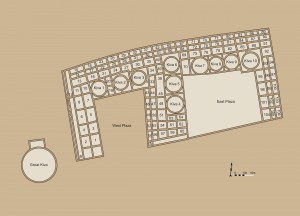Chaco Sites
Kin Bineola
Site Description:
Kin Bineola is Navajo for “house in which the wind whirls” or “house the wind blows around.” The site is a large Chacoan great house built along the Kin Bineola Wash about 12 miles (19 km.) southwest of Pueblo Bonito. Kin Bineola was connected to the canyon by a Chacoan road. Several archaeologists, citing architectural attributes (some rooms have the Type I masonry also found in the earliest sections of Pueblo Bonito, Peñasco Blanco, and Una Vida) and tree-ring dates, believe some rooms in the central wing of the structure were built about A.D. 940-945, but most of the site appears to have been constructed between A.D. 1110-1120, with suggestions of limited construction in the mid-11th century. Unfortunately many beams were taken from the ruin in the 18th and 19th centuries for use as fuel or building material.
The plan of Kin Bineola was E-shaped, different from the more classic D-shape found at Chetro Ketl, Pueblo Bonito, or Pueblo Alto. There was no fronting arc of rooms connecting the southwestern and northeastern room blocks, but the east plaza was enclosed by a straight wall between the central and northeastern room blocks. The building rose to three stories on the north and contained almost 200 rooms and 10 kivas. A great kiva approximately 50 feet (15 m.) in diameter lies about 30 feet (9 m.) southwest of the great house.
Like nearby Kin Klizhin, this great house was probably established to take advantage of the farming potential of the valley. A prehistoric water control system has been documented along the Kin Bineola Wash to the south and west of the great house. Photographs of Navajo agricultural fields taken by the National Geographic Expedition in the 1920s reveal sizable harvests.
Alternative site designations include Kinbinyoli, Kin Benyola, Kimenioli, Kimineoli, Kimmenioli, Kimbenaiola, and 29SJ1580.
Excavation History
- Kin Bineola has never been excavated, but Alex Hrdlicka of the Hyde Exploring Expedition uncovered several burials in the vicinity of the great house in 1899.
Size and Dates
- Approximately 200 rooms, 10 kivas, and one great kiva.
- Construction began by the mid-10th century and continued through the first decades of the 12th century.
Site and Room Data
- Aztec West Ruins
- Bc 50 - Tseh So
- Bc 51
- Bc 53 - Roberts' Site
- Bc 57
- Bc 58
- Bc 59
- Chetro Ketl
- Pueblo Bonito
- Pueblo del Arroyo
- Shabik'eshchee
- Talus Unit #1


